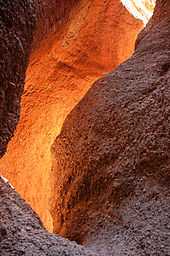Purnululu National Park
| Purnululu National Park | |
|---|---|
| Name as inscribed on the World Heritage List | |
 | |
| Type | Natural |
| Criteria | VII, VIII |
| Reference | 1094 |
| UNESCO region | Asia-Pacific |
| Inscription history | |
| Inscription | 2003 (27th Session) |
| Purnululu National Park | |
|---|---|
|
IUCN category II (national park) | |
 | |
| Nearest town or city | Halls Creek |
| Coordinates | 17°27′47″S 128°33′51″E / 17.46306°S 128.56417°ECoordinates: 17°27′47″S 128°33′51″E / 17.46306°S 128.56417°E |
| Area | 239,723 ha[1] |
| Established | 1987 |
| Managing authorities | Department of Environment and Conservation |
| Official site | Purnululu National Park |
Purnululu National Park is a national park in the Kimberley region of Western Australia. It was declared a World Heritage Site in 2003.
Location

It is located in north east of Western Australia. The nearest major town is Kununurra to the north, or Halls Creek to the south.
Purnululu is the name given to the sandstone area of the Bungle Bungle Range by the Kija Aboriginal people. The name means sandstone or may be a cordon of bundle grass. The range, lying fully within the park, has elevations as high as 578 metres above sea level. It is famous for the sandstone domes, unusual and visually striking with their striping in alternating orange and grey bands. The banding of the domes is due to differences in clay content and porosity of the sandstone layers: the orange bands consist of oxidised iron compounds in layers that dry out too quickly for cyanobacteria to multiply; the grey bands are composed of cyanobacteria growing on the surface of layers of sandstone where moisture accumulates.
Geology

The Bungle Bungle Range is one of the most extensive and impressive occurrences of sandstone tower (or cone) karst terrain in the world. The Bungle Bungles were a plateau of Devonian sandstone, carved into a mass of beehive-shaped towers with regularly alternating, dark gray bands of cynobacterial crust (single cell photosynthetic organisms). The plateau is dissected by 100-200 m deep, sheer-sided gorges and slot canyons. The cone-towers are steep-sided, with an abrupt break of slope at the base and have domed summits. How they were formed is not yet completely understood. Their surface is fragile but stabilized by crusts of iron oxide and bacteria. They provide an outstanding example of land formation by dissolutional weathering of sandstone, with removal of sand grains by wind, rain and sheet wash on slopes. [2]
Access
Access to the park by road is via Spring Creek Track, from the Great Northern Highway approximately 250 km south of Kununurra, to the track's end at the visitor centre. The track is 53 km long and is usable only in the dry season (about 1 April to 31 December), and only by four-wheel-drive (4WD) vehicles. Safely navigating it takes approximately 3 hours. Access by air is less demanding; helicopter flights are available, from Bellburn Airstrip in the national park, and light aircraft, from both Warmun, 187 km south of Kununurra.
The traditional owners of the area are the Kitja peoples.[3]
See also

- Protected areas of Western Australia
- Kimberley (Western Australia)
- Encyclopedia of Earth-Purnululu National Park
References
- ↑ Department of Environment and Conservation 2009–2010 Annual Report. Department of Environment and Conservation. 2010. p. 48. ISSN 1835-114X.
- ↑ Purnululu National Park, Australia at Encyclopedia of Earth
- ↑ "Ausanthrop - Australian Aboriginal tribal database". 2012. Retrieved 29 April 2012.
Further reading
- Hoatsan, Dean et al.(1997) Bungle Bungle Range : Purnululu National Park, East Kimberley, Western Australia : a guide to the rocks, landforms, plants, animals, and human impact Canberra : Australian Geological Survey Organisation. ISBN 0-642-25010-3
External links

![]() Media related to Purnululu National Park at Wikimedia Commons
Media related to Purnululu National Park at Wikimedia Commons
| |||||||||||||||||||||||||||||